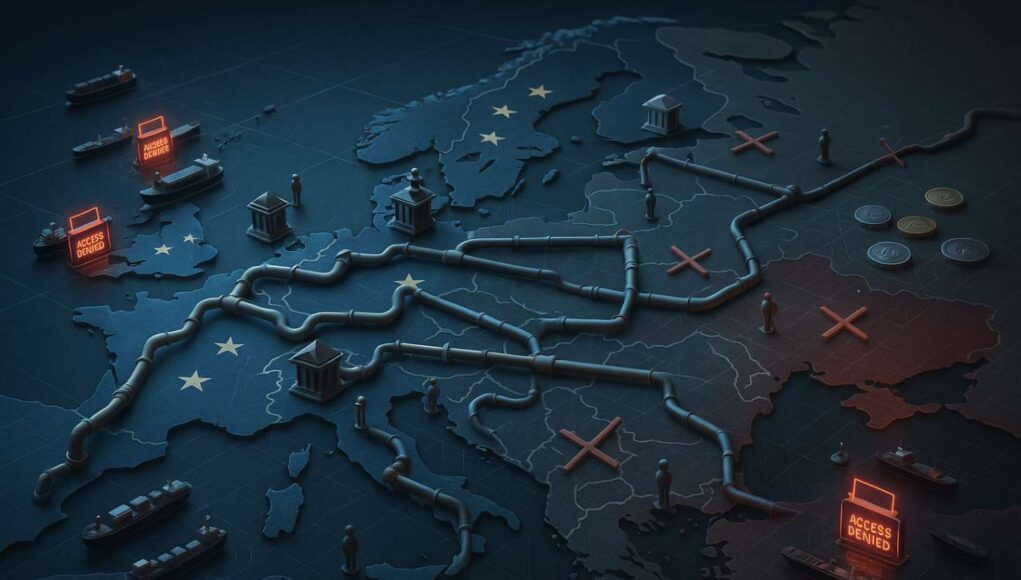On October 23, 2025, the European Union adopted its 19th sanctions package against Russia. This sweeping update targets every remaining channel Moscow uses to fund or bypass restrictions. Consequently, it reshapes how energy, finance, and crypto interact under EU law. Beyond a phased LNG ban, the package adds new limits on third-country banks and penalties on the shadow fleet. For the first time, Brussels has also turned to digital assets. It blacklists the ruble-linked A7A5 stablecoin, restricts crypto-payment services, and bans EU operators from using Russia’s MIR and SBP payment systems. Ultimately, the move cements the EU crypto sanctions framework as a permanent tool of economic defense.
Energy Takes the Lead — LNG and the Shadow Fleet
Energy remains the core target of the EU 19th sanctions package. The measures include a ban on Russian liquefied natural gas (LNG) imports, with separate timelines for long-term and spot contracts. Therefore, the EU can minimize disruption to its supply chains while tightening Russia’s revenue flow.
For shipping, the EU expanded its crackdown on the shadow fleet, vessels that move sanctioned energy under hidden ownership. More than 100 ships are now listed, barred from EU ports, and denied EU-based insurance and reinsurance. In addition, these combined actions aim to cut Moscow’s export income and weaken offshore logistics networks. Together, the LNG ban and shadow fleet sanctions provisions form the bloc’s strongest energy action since the oil-price-cap mechanism of 2023.
>>> Read more: Russia’s Crypto Loophole: Can Sanctions Stop Oil Trade?
Financial Pressure Tightens on Banks and Payment Systems
The EU‘s 19th sanctions package also widens restrictions on Russian and third-country banks. The list now covers intermediaries in the UAE, Hong Kong, and Central Asia accused of helping Russia evade earlier rounds. Moreover, the EU now prohibits engagement with Russia’s domestic payment networks, the MIR payment system, and the SBP fast payments platform. European financial institutions and fintech providers must sever all technical and contractual links to these systems. As a result, the EU closes lingering loopholes in cross-border settlement, where sanctioned actors once converted crypto or fiat through regional intermediaries. The broader financial sanctions block hybrid corridors that previously bridged Moscow’s domestic rails with the global economy.
The Crypto Pivot — A7A5 Stablecoin Blacklisted
For the first time, an EU sanctions package singles out a stablecoin. The A7A5 stablecoin, pegged to the Russian ruble and used to settle offshore trades, has been blacklisted. All A7A5 transactions are prohibited within the European Union, and the individuals behind its issuance are now sanctioned.
Consequently, this step establishes the first Russian stablecoin ban at the European level. It also limits crypto-payment services and custodial providers that may process transfers tied to sanctioned wallets. EU officials describe the move as a direct response to sanctions evasion via crypto. Digital assets, they note, are increasingly used to mask trade settlements, donations, and asset flows linked to sanctioned entities. Therefore, the decision marks a turning point. Digital-asset transfers are now treated as part of the same enforcement perimeter as fiat banking. The EU crypto sanctions framework has evolved from theory into an operational system of control.
>>> Read more: U.S. Sanctions Garantex & Grinex, Offers $6M Bounty
Service and Tech Restrictions Broaden Compliance Duties
Beyond energy and finance, the EU’s sanctions package extends to services provided to the Russian government and listed entities. It now restricts AI, high-performance computing (HPC), finance-related software, and certain space-based commercial services. In particular, these changes are intended to prevent dual-use technology from feeding Russia’s industrial base. For fintech and regtech firms, the rule means tighter end-user verification. Consequently, every client and vendor relationship now carries an additional compliance burden.
What EU VASPs Must Do Now
The inclusion of A7A5 stablecoin and crypto-payment bans creates immediate duties for Virtual Asset Service Providers (VASPs) under MiCA rules. VASPs must run geofencing checks, update sanctions-screening software, and ensure travel-rule tools include the new lists. Additionally, they must report any suspicious or failed transaction involving sanctioned wallets promptly to national authorities.
Immediate steps:
- Blacklist A7A5 wallet addresses and suspend any related transactions.
- Screen all customers and vendors for exposure to newly sanctioned entities.
- Disable payment channels linked to MIR/SBP to block indirect settlements.
These procedures align with the EU VASP compliance framework, where sanctions screening and blockchain analytics are mandatory safeguards, not optional measures.
Enforcement and Industry Response
Regulators such as DG FISMA, ESMA, and national financial intelligence units will issue technical guidance soon. Meanwhile, early industry reactions show exchanges and custodians already tightening geofences and disabling ruble-pegged pairs. Compliance vendors are updating databases with A7A5 identifiers, and blockchain-analysis firms are mapping related wallet clusters.
As a result, enforcement will merge with MiCA’s travel-rule architecture, giving regulators a live view of digital-asset sanctions. At the same time, the shadow fleet sanctions and the LNG ban require new oversight for logistics financing and maritime insurance. Energy, finance, and crypto have become inseparable fronts in the EU’s sanctions strategy.
>>> Read more: Russia’s Crypto Economy: Strategy or Sovereign Parallel?
In summary, the EU‘s 19th sanctions package combines energy restrictions, financial closures, and digital-asset controls in one coordinated framework. By banning the A7A5 stablecoin, cutting off MIR and SBP, and enforcing EU crypto sanctions through regulated VASPs, Brussels has closed every gap left in prior rounds. Overall, crypto now stands beside LNG, banks, and high-tech exports as a monitored channel of pressure. For digital-asset businesses, compliance is no longer optional. Operating within the EU means aligning fully with its sanctions architecture, and this time, no escape route remains open.
Readers’ frequently asked questions
What legal framework allows the EU to sanction crypto assets like A7A5?
Crypto sanctions are enforced under the same legal basis as financial restrictions, Council Regulation (EU) No 833/2014. The 19th package extends its scope to include virtual assets, allowing the EU to list tokens, wallets, and service providers alongside banks or energy firms.
How will these sanctions interact with MiCA once it’s fully enforced?
Under MiCA, EU-licensed exchanges and custodians follow uniform supervision and disclosure standards. The new sanctions will integrate into that system, enabling regulators to monitor compliance and freeze wallets across the EU using shared data infrastructure.
Could the A7A5 ban affect non-EU users trading with European platforms?
Yes. Non-EU users who access EU-based exchanges or custodial services fall under EU jurisdiction when transacting in restricted assets. Even if their country has no similar ban, platforms must block A7A5 activity to remain MiCA-compliant and avoid secondary-sanctions risk.
What Is In It For You? Action items you might want to consider
Check if your exchange or wallet supports A7A5
If you hold or have traded the A7A5 stablecoin, confirm whether your exchange or wallet has restricted it. Many EU platforms have already disabled A7A5 deposits and withdrawals under the new sanctions.
Avoid using MIR or SBP payment apps for transfers
The MIR payment system and SBP fast payments platform are now banned in the EU. Using them for crypto or fiat transfers could result in blocked transactions or frozen accounts on regulated exchanges.
Watch for updated compliance notices from your exchange
Crypto platforms licensed under MiCA must inform users of new sanction-related restrictions. Always read official exchange notices and alerts — ignoring them could cause interrupted access or delayed withdrawals.










